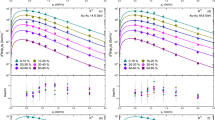Abstract
Different from the early universe, heavy-ion collisions at very high energies do not reach statistical equilibrium, although thermal models explain many of their features. To account for nonequilibrium strong-coupling effects, a Fokker-Planck equation with time-dependent diffusion coefficient is proposed. A schematic model for rapidity distributions of participant baryons is set up and solved analytically. The evolution from SIS via AGS and SPS to RHIC energies is discussed. Strong-coupling diffusion produces double-peaked spectra in central collisions at the higher SPS momentum of 158 A.GeV/c and beyond.
Similar content being viewed by others
Author information
Authors and Affiliations
Rights and permissions
About this article
Cite this article
Wolschin, G. Strong-coupling diffusion in relativistic systems. Pramana - J Phys 60, 1035–1038 (2003). https://doi.org/10.1007/BF02707026
Issue Date:
DOI: https://doi.org/10.1007/BF02707026
Keywords
- Relativistic heavy-ion collisions
- fluctuation phenomena
- relativistic diffusion model
- net-proton rapidly distributions
- approach to thermal equilibrium




